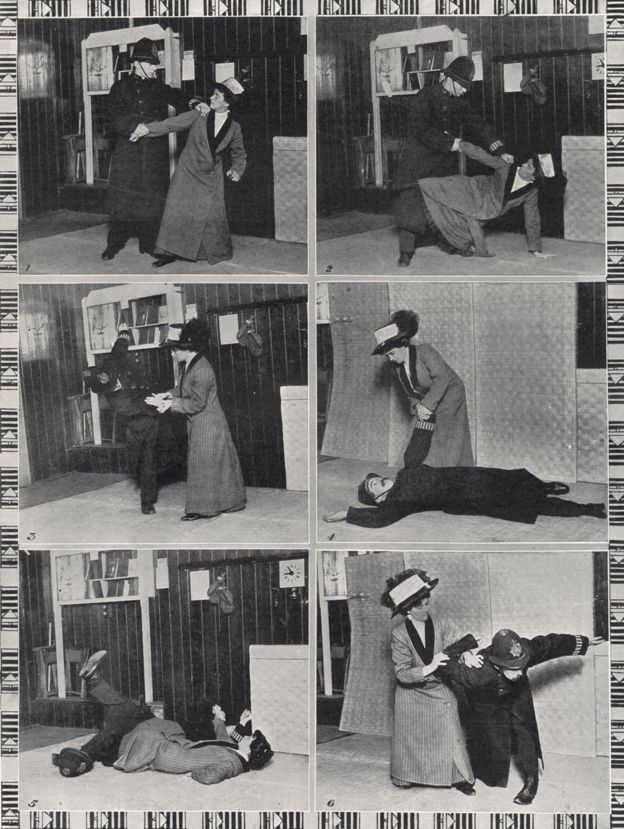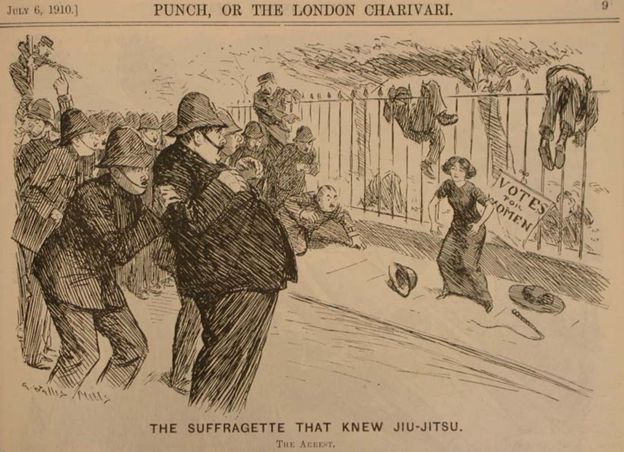It looks like you're using an Ad Blocker.
Please white-list or disable AboveTopSecret.com in your ad-blocking tool.
Thank you.
Some features of ATS will be disabled while you continue to use an ad-blocker.
9
share:


(pictured above) "a suffragette's guide to self-defense"
~| source |~
Before going to bed last night, I learned something new. Now, before I get started I wanted to say that I don't consider myself a feminist--nor do I support the current feminist movement--but, I must say that I DO admire how adamant and steadfast the suffragettes were in their struggle to gain the right to vote by challenging popular opinion during a time when such a notion was considered absurd.
I knew that the women who were a part of the suffrage movement did plenty of things to bring attention to their cause--including one instance where a woman threw herself on the horse track and committed suicide. But I had never heard of how they learned jiu-jitsu in order to "defend...themselves against angry hecklers in the audience who got on stage".
Apparently, these brave women were victims of a number of physical assaults against them for speaking their mind. So, because of that, they decided to teach themselves self-defense in order to cope with the backlash.
At the center of this surprising revelation was a very petite woman named Edith Garrud. She was only 4ft 11in in height--someone who appeared to be no match for the brawny officers in the Metropolitan Police who were required, at the time, to be at least 5ft 10in in height.
But, in the lead-up to WWI, Garrud became a jiu-jitsu instructor for the Women's Social and Political Union (WSPU)--better known as the suffragettes. As I stated previously, these women had become subject to increasing violence during their campaign for voting rights. However, these women had begun to resort to increasingly extreme tactics due to their frustration at the lack of progress in their campaign. Civil disobedience and hunger strikes are probably the most commonly-mentioned tactics, but these women also were the perpetrators of various illegal activities, including assault and arson.
Before Black Friday on the 18th of November in 1910, plenty of the demonstrators had complained of being manhandled and tossed to the ground while taking part in their marches. But on that Friday, their movement took a violent turn when a group of 300 suffragettes were met with a wall of policemen outside Parliament--and the women were heavily outnumbered. The women were assaulted by both the police and male vigilantes within the crowd. Many were injured--and two women died from the serious injuries that they had sustained as a result.
Some suffragettes began putting cardboard over their ribs as make-shift protection, but Garrud had a better idea. She was already teaching the WSPU to fight back using the ancient Japanese martial art of jiu-jitsu. Jiu-jitsu emphasizes using one's opponent's force against them via channeling their momentum and by using pressure points (as shown in the top image).
Garrud and her husband, William, ran a martial arts school in London's Golden Square together. Edith was normally the one who demonstrated at WSPU meetings while her husband spoke--and on one occasion, they had been planning on attending together, but William was ill so Edith decided to go on her own.
WSPU's leader, Emmeline Pankhurst, encouraged Edith to speak for once--which she did. After this, Garrud began teaching the martial art to some of the suffragettes. By 1910, Edith Garrud was regularly teaching suffragette-only classes and wrote articles for the WSPU's magazing, "Votes for Women", in which she emphasized the importance of jiu-jitsu in dealing with a larger and more powerful force than oneself--namely the police and government.
Garrud was one of the first female martial art instructors in the West.

(pictured above) an image from Punch magazine depicting a cartoon of Garrud standing alone against policemen
The press took notice, and published a satirical piece in the magazine Health and Strength called, "Jiu-jitsuffragettes". The term, "suffrajitsu" soon became commonplace.
"They wouldn't have expected in those days that women could respond physically to that kind of action, let alone put up effective resistance," says Martin Dixon, chairman of the British Jiu-Jitsu Association. "It was an ideal way for them to handle being grabbed while in a crowd situation."
Jiu-jitsu became a society trend, with women hosting jiu-jitsu parties where they and their friends learned the martial art--a fighting form that emphasizes skill over power.
Finally, after the end of WWI, in 1918 the Representation of the People Act allowed women over 30 to vote--and in 1928 women over 21 became allowed to vote.
In sum, I was blown away by the bravery and innovation that it must have taken to launch such an effort. When I first saw the title of the article, I thought that it was some kind of joke--and then saw how wrong I was. I can't believe that this chapter of history was not taught to me in school--but I am so happy that I know it now. I hope that you enjoyed learning about suffrajitsu as much as I did. Truly, we have all come a long way from those days--and luckily such violent actions are no longer necessary. But, we should take some time to remember the brave women who risked their lives and reputations for the betterment of all women.
On the same note, I think that modern-day feminists should remember their roots--and remember that we have come a long way from the way things were in the early 1900's.
edit on 5-10-2015 by rukia because: adding a banner
The English suffragettes used a little of this, and were more militant than the American suffragists, who were nonviolent. A tiny woman who packed a
big whallop, probably would be maced, stunned, and/or shot if she tried this today. Well, maybe not in England, they'd just hold their hand on her
forehead and let her flail away.
Great thread! Thanks!
Love stories like this especially since i'm involved in the Self-Defense industry.
Awesome!
Love stories like this especially since i'm involved in the Self-Defense industry.
Awesome!
You would appreciate these:
edit on 5-10-2015 by AugustusMasonicus because: Ph'nglui mglw'nafh Cthulhu R'lyeh wgah'nagl fhtagn
a reply to: AugustusMasonicus
your video links aren't working, unfortunately. I am interested in seeing them--if you'd fix them that would be super!
Edit: you're already ahead of me--thank you very much!
your video links aren't working, unfortunately. I am interested in seeing them--if you'd fix them that would be super!
Edit: you're already ahead of me--thank you very much!
edit on 5-10-2015 by rukia because: (no reason given)
a reply to: rukia
Love it, I always admired these ladys and wish modern brit's had the same spirit both men and woman but this is news to me and that old newspaper cartoon the suffrogette that knew jiu jitsu made me chuckle as well as reminding me of my mother, hope she does not read this.
Love it, I always admired these ladys and wish modern brit's had the same spirit both men and woman but this is news to me and that old newspaper cartoon the suffrogette that knew jiu jitsu made me chuckle as well as reminding me of my mother, hope she does not read this.
new topics
-
New Jersey-Teachers Can Now Be Certified Without Passing Basic Reading Writing Math Testing
Education and Media: 1 hours ago -
Matthew Livelsberger said he was being followed by FBI
Political Conspiracies: 4 hours ago -
How the Sikhs Deal with Muslim Grooming Gangs – Tommy Robinson
Social Issues and Civil Unrest: 6 hours ago -
Paranoid Liberals Believe U.S. Service Members are More Dangerous than Illegal Aliens.
Social Issues and Civil Unrest: 7 hours ago -
The 119th Congress has Officially Opened for Business
Mainstream News: 8 hours ago -
Here we again... CHINA having mass outbreak of something
Diseases and Pandemics: 8 hours ago
top topics
-
Musk calls on King Charles III to dissolve Parliament over Oldham sex grooming gangs
Mainstream News: 14 hours ago, 14 flags -
Matthew Livelsberger said he was being followed by FBI
Political Conspiracies: 4 hours ago, 13 flags -
The Why Files Lacerta Reveals the Truth of our Creation
Aliens and UFOs: 16 hours ago, 11 flags -
FIEND SLASHED: Sara Sharif’s killer dad ‘has neck & face sliced open with jagged tuna tin lid
Mainstream News: 13 hours ago, 10 flags -
Grenfell Tower Fire revisited
Mainstream News: 15 hours ago, 9 flags -
Here we again... CHINA having mass outbreak of something
Diseases and Pandemics: 8 hours ago, 8 flags -
The 119th Congress has Officially Opened for Business
Mainstream News: 8 hours ago, 7 flags -
How the Sikhs Deal with Muslim Grooming Gangs – Tommy Robinson
Social Issues and Civil Unrest: 6 hours ago, 6 flags -
Paranoid Liberals Believe U.S. Service Members are More Dangerous than Illegal Aliens.
Social Issues and Civil Unrest: 7 hours ago, 5 flags -
Flee from idolatry
Religion, Faith, And Theology: 13 hours ago, 3 flags
active topics
-
Matthew Livelsberger said he was being followed by FBI
Political Conspiracies • 34 • : fringeofthefringe -
Ukraine halts transit of Russian gas to Europe after a prewar deal expired
Political Conspiracies • 143 • : xuenchen -
US disburses $3.4 billion in budget aid for Ukraine, Yellen says
US Political Madness • 29 • : xuenchen -
New Jersey-Teachers Can Now Be Certified Without Passing Basic Reading Writing Math Testing
Education and Media • 5 • : nugget1 -
Tesla Cybertruck Explodes in Front of Trump Hotel in Las Vegas
Mainstream News • 187 • : cherokeetroy -
Here we again... CHINA having mass outbreak of something
Diseases and Pandemics • 12 • : Athetos -
Paranoid Liberals Believe U.S. Service Members are More Dangerous than Illegal Aliens.
Social Issues and Civil Unrest • 21 • : xuenchen -
Musk calls on King Charles III to dissolve Parliament over Oldham sex grooming gangs
Mainstream News • 87 • : gort69 -
Flee from idolatry
Religion, Faith, And Theology • 7 • : FullHeathen -
Candidate TRUMP Now Has Crazy Judge JUAN MERCHAN After Him - The Stormy Daniels Hush-Money Case.
Political Conspiracies • 2170 • : xuenchen
9
